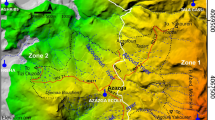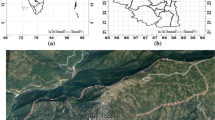Abstract
The monsoon season in Cameroon is often marked by heavy rainfall and landslides across Bamenda Mountain Region causing heavy material damage and human casualties. This paper presents a model to assess the temporal probability of rainfall-induced landslides in the area. Landslide events from 1994 to 2013 collected from literature review, field work, aerial photo and satellite image interpretation, and rainfall data from the Bamenda weather station for the same period were used to determine rainfall thresholds for landslide initiation. Two threshold determination methods (intensity–duration and daily antecedent rainfall) were used to determine rainfall characteristics that initiate landslides. Then the number of times rainfall exceeded the different thresholds was estimated, and the results were fitted into the poison model to assess the temporal probability of landsliding for 1, 5, 10 and 25-year return period. Each of the thresholds was validated using rainfall and landslide events for 2009 that were not used in building the model. The results showed that rainfall intensity of 94 mm in 1 day and rainfall of 96 mm with 0.49 of 10-day antecedent rainfall triggered landslides in the area. The validation of these results showed only one landslide falling below each of the threshold curves. The temporal probability of landslides varied from 0.27 to 0.38 using the rainfall intensity–duration approach and 0.28–0.41 for the daily antecedent rainfall approach. The true forecast rate stood at 89 %, and the failure to predict probability was 0.11. The model shows a high correlation between rainfall and landsliding, and the temporal probability can be used for land-use planning and civil protection.
Similar content being viewed by others
References
Afungang R (2013) Erosion mass movement and landscape dynamics in the Mezam Highland of Cameroon. CEGOT 1st international meeting, 4–6 March 2013, Porto
Afungang R (2015) Spatiotemporal probabilistic assessment of landslide hazard along the Bamenda Mountain Region of the Cameroon volcanic line. PhD thesis, University of Porto
Aleotti P (2004) A warning system for rainfall-induced shallow failures. Eng Geol 73(3–4):247–265. doi:10.1016/j.enggeo.2004.01.007
Ascenso V (2011) Análise da ocorrência de cheias e deslizamentos de vertente no Concelho da Batalha. Master thesis in Physical Geography, Institute of Geography and Spatial Planning, University of Lisbon
Ayonghe S, Mafany G, Ntasin E, Samalang P (1999) Seismically activated swarm of landslides, tension cracks, and a rockfall after heavy rainfall in Bafaka, Cameroon. Nat Hazards 19:13–27
Ayonghe S, Ntasin E, Samalang P, Suh C (2004) The June 27, 2001 landslide on volcanic cones in Limbe, Mount Cameroon, West Africa. J Afr Earth Sci 39:435–439
Bai S, Jian W, Thiebes B, Chen C, Yang Y (2014) Analysis of the relationship of landslide occurrence with rainfall: a case study of Wudu County, China. Arab J Geosci 7:1277–1285
Baum RL, Godt JW, Savage WZ (2010) Estimating the timing and location of shallow rainfall-induced landslides using a model for transient, unsaturated infiltration. J Geophys Res 115. doi:10.1029/2009JF001321
Bhandari R, Negi S, Solzbacher E (2010) Wafer-scale fabrication of penetrating neural microelectrode arrays. Biomed Microdevices 12(5):797–807
Brunetti MT, Peruccacci S, Rossi M, Luciani S, Valigi D, Guzzetti F (2010) Rainfall thresholds for the possible occurrence of landslides in Italy. Nat Hazards Earth Syst Sci 10:447–458
Bui DT, Pradhan B, Lofman O, Revhaug I, Dick O (2012) Spatial prediction of landslide hazards in Hoa Binh province (Vietnam): a comparative assessment of the efficacy of evidential belief functions and fuzzy logic models. Catena 96:28–40. doi:10.1016/j.catena.2012.04.001
Caine N (1980) The rainfall intensity-duration control of shallow landslides and debris flows. Geogr Ann Ser A 62(1–2):23–27
Cannon S, Boldt E, Laber J, Kean J, Staley D (2011) Rainfall intensity–duration thresholds for postfire debris flow emergency-response planning. Nat Hazards 59(1):209–236
Canuti P, Focardi P, Garzonio C (1985) Correlation between rainfall and landslides. Bull Int Assoc Eng Geol 32:49–54
Chleborad A, Baum R, Godt JW (2006) Rainfall thresholds for forecasting landslides in the Seattle, Washington, area-exceedance and probability. U.S. Geological Survey Open-File Report 2006–1064. https://pubs.usgs.gov/of/2006/1064/pdf/of2006-1064.pdf
Coe JA, Michael J, Crovelli R, Savage W, Laprade W, Nashem W (2004) Probabilistic assessment of precipitation-triggered landslides using historical records of landslide occurrence, Seattle, Washington. Environ Eng Geosci 10(2):103. doi:10.2113/10.2.103
Corominas J, Moya J (2008) A review of assessing landslide frequency for hazard zoning purposes. Eng Geol 102(3–4):193–213. doi:10.1016/j.enggeo.2008.03.018
Crosta GB, Frattini P (2003) Distributed modelling of shallow landslides triggered by intense rainfall. Nat Hazards Earth Syst Sci 3:81–93
Crovelli RA (2000) Probability models for estimation of number and costs of landslides. United State geological survey open file report 00-249. http://pubs.usgs.gov/of/2000/ofr-00-0249/ProbModels.html
Crozier MJ (1999) Prediction of rainfall-triggered landslides: a test of the antecedent water status model. Earth Surface Process Landf 24(9):825–833
Dahal R, Hasegawa S (2008) Representative rainfall thresholds for landslides in the Nepal Himalaya. Geomorphology 100(3–4):429–443. doi:10.1016/j.geomorph.2008.01.014
Ellen SD, Wieczorek GF (1988) Landslides, floods, and marine effects of the storm of January 3–5, 1982, in the San Francisco Bay Region, California. U.S. geological survey professional paper 1434, pp 1–283
Eze B, Ndenencho E (2004) Geomorphic and anthropic factors influencing landslides in the Bamenda Highlands, N. W. Province, Cameroon. J Appl Soc Sci 4(1):15–26
Gabet EJ, Burbank DW, Putkonen JK, Pratt-Sitaula BA, Oiha T (2004) Rainfall thresholds for landsliding in the Himalayas of Nepal. Geomorphology 63:131–143
Giannecchini R, Galanti R, Amato A (2012) Critical rainfall thresholds for triggering shallow landslides in the Serchio River Valley (Tuscany, Italy). Nat Hazards Earth Syst Sci 12:829–842
Glade T, Crozier M, Smith P (2000) Applying probability determination to refine landslide triggering rainfall thresholds using empirical “Antecedent daily rainfall model”. Pure appl Geophys 157:1059–1079
Godt J, Baum R, Chleborad A (2005) Rainfall characteristics for shallow landsliding in Seattle, Washington, USA. Earth Surf Process Landf 31(1):97–110
Godt JW, Baum RB, Savage WZ, Salciarini D, Schulz WH, Harp EL (2008) Transient deterministic shallow landslide modeling: requirements for susceptibility and hazard assessments in a GIS framework. Eng Geol 102:214–226
Gokceoglu C, Sezer E (2009) A statistical assessment on international landslide literature (1945–2008). Landslides 6:345–351
Gountié DM, Njonfang E, Nono A, Kamgang P, Zangmo TG, Kagou Dongmo A, Nkouathio DG (2012) Dynamic and evolution of the Mounts Bamboutos and Bamenda calderas by study of ignimbritic deposits (West-Cameroon, Cameroon Line). Syllabus Rev Sci Ser 3:11–23
Govi M, Sorzana PF (1980) Landslide susceptibility as function of critical rainfall amount in Piedmont basin (North-Western Italy). Stud Geomorphol Carpatho Balc 14:43–60
Guedjeo C, Kagou D, Ngapgue F, Nkouathio D, Zangmo T, Gountié D, Nono A (2013) Natural hazards along the Bamenda escarpment and its environs: the case of landslide, rock fall and flood risks (Cameroon volcanic line, North-West Region). Glob Adv Res J Geol Min Res 2(1):015–026
Gumbel E (1958) Statistics of extremes. Columbia University Press, New York, ISBN 0231021909 9780231021906
Gutierrez F, Soldati M, Audemard F, Balteanu D (2010) Recent advances in landslide investigation: issues and perspectives. Geophys J Roy Astron Soc 124:95–101
Guzzetti F, Peruccacci S, Rossi M, Stark C (2007) Rainfall thresholds for the initiation of landslides in central and Southern Europe. Meteorol Atmos Phys 98(3):239–267. doi:10.1007/s00703-007-0262-7
Guzzetti F, Peruccacci S, Rossi M, Stark CP (2008) The rainfall intensity–duration control of shallow landslides and debris flows: an update. Landslides 5(1):3–17
Havenith HB, Strom A, Jongmans D, Abdrakhmatov K, Delvaux D, Tréfois P (2003) Seismic triggering of landslides, part A: field evidence from the Northern Tien Shan. Nat Hazards Earth Syst Sci 3:135–149
Iverson R (2000) Landslide triggering by rain infiltration. Water Resour Res 36(7):1897–1910
Jaiswal P, van Westen C (2009) Estimating temporal probability for landslide initiation along transportation routes based on rainfall thresholds. Geomorphology 112(1–2):96–105
Jakob M, Holm K, Lange O, Schwab JW (2006) Hydrometeorological thresholds for landslide initiation and forest operation shutdowns on the north coast of British Columbia. Landslides 3:228–238
Lambi CM (2004) Revisit of the recurrent landslides on the Bamenda escarpment. J Appl Soc Sci 4(1):4–14
Malamud BD, Turcotte DL, Guzzetti F, Reichenbach P (2004) Landslide inventories and their statistical properties. Earth Surf Process Landf 29:687–711
Marques R, Zêzere J, Trigo R, Gaspar J, Trigo I (2008) Rainfall patterns and critical values associated with landslides in Povoação County (São Miguel Island, Azores): relationships with the North Atlantic Oscillation. Hydrol Process 22(4):478–494
Martelloni G, Segoni S, Fanti R, Catani F (2011) Rainfall thresholds for the forecasting of landslide occurrence at regional scale. Landslides 9(4):485–495. doi:10.1007/s10346-011-0308-2
Montgomery DR, Dietrich WE (1994) A physically based model for the topographic control on shallow Landsliding. Water Resour Res 30:1153–1171
Ndenecho EN (2011) Local livelihoods and protected area management—biodiversity conservation problems in Cameroon. Langaa, RPCIG, Cameroon. http://www.africanbookscollective.com/books/local-livelihoods-and-protected-area-management
Petrucci O, Polemio M (2009) The role of meteorological and climatic conditions in the occurrence of damaging hydro-geologic events in Southern Italy. Nat Hazards Earth Syst Sci 9(1):105–118
Polemio M, Sdao F (1999) The role of rainfall in the landslide hazard: the case of the Avigliano urban area (Southern Apennines, Italy). Eng Geol 53(3–4):297–309. doi:10.1016/s0013-7952(98)00083-0
Saito H, Nakayama D, Matsuyama H (2010) Relationship between the initiation of a shallow landslide and rainfall intensity–duration thresholds in Japan. Geomorphology 118(1–2):167–175
Salciarini D, Godt JW, Savage WZ, Baum RL, Conversini P (2008) Modeling landslide recurrence in Seattle, Washington, USA. Eng Geol 102(3–4):227–237
Simoni S, Fabrizio Z, Giacomo B, Rigon R (2007) Modelling the probability of occurrence of shallow landslides and channelized debris flows using GEOtop-FS. Hydrol Process 22(4):532–545
Terlien MJ (1998) The determination of statistical and deterministic hydrological landslide-triggering thresholds. Environ Geol 35:124–130
Tiranti D, Rabuffetti D (2010) Estimation of rainfall thresholds triggering shallow landslides for an operational warning system implementation. Landslides 4(7):471–481
Varnes DJ, IAEG Commission on Landslides and other Mass-Movements (1984) Landslide hazard zonation: a review of principles and practice. The UNESCO Press, Paris, p 63
Wieczorek GF, Morgan BA, Campbell RH (2000) Debris flow hazards in the Blue Ridge of central Virginia. Environ Eng Geosci 6:3–23
Wilson RC, Wieczorek GF (1995) Rainfall thresholds for the initiation of debris flow at La Honda, California. Environ Eng Geosci 1:11–27
Zêzere J, Trigo R, Trigo I (2005) Shallow and deep landslides induced by rainfall in the Lisbon region (Portugal): assessment of relationships with the North Atlantic Oscillation. Nat Hazards Earth Syst Sci 5:331–344
Author information
Authors and Affiliations
Corresponding author
Rights and permissions
About this article
Cite this article
Afungang, R.N., Bateira, C.V. Temporal probability analysis of landslides triggered by intense rainfall in the Bamenda Mountain Region, Cameroon. Environ Earth Sci 75, 1032 (2016). https://doi.org/10.1007/s12665-016-5835-7
Received:
Accepted:
Published:
DOI: https://doi.org/10.1007/s12665-016-5835-7












